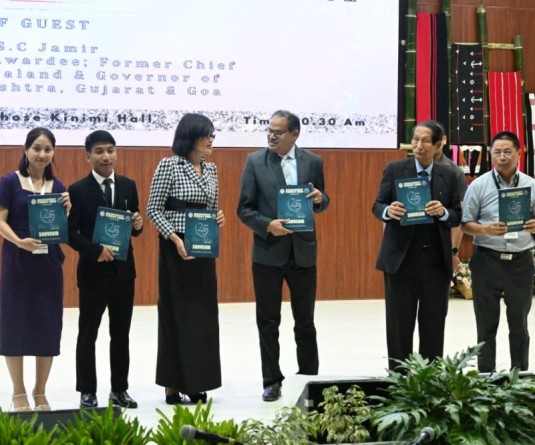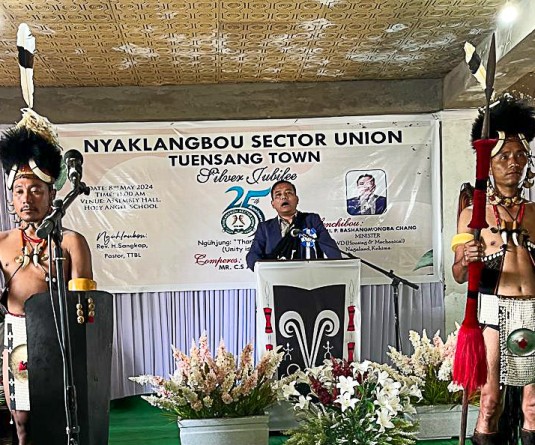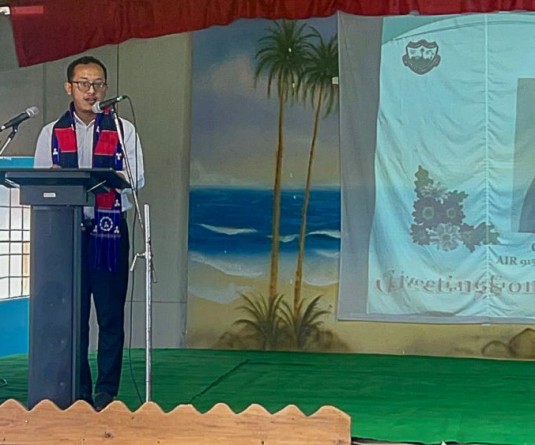
Constraints and limitations
Our Correspondent
Kohima | September 20
Pork is the most favoured protein food source for the people of Nagaland. It is a traditional practice for most of the agricultural farmers in villages to rear one or two pigs in their backyard as a source of subsidiary income to meet exigency expenses.
However, the state is yet to attain self-sufficiency in pork despite the fact that pig rearing has been a traditional practice for the people for its socio-economic association.
Nagaland with a swine population of 5,03,688 as per 19th QQL livestock 2012 census, pork constitutes 60% of the total meat food requirement, and the state is still dependent on other states for the meat.
Several reasons have been identified for the failure to produce enough meat. The existing pig population generally reared by most in Nagaland are no-descript animals. These animals have got themselves established over time through self-propagation resulting from exchange of genes among various swine breeds. The genetic potential of these animal are yet to be determined like that of a recognized breed of swine possessing defined productive trait.
Pig farmers of the state generally do not practice systematic system breeding. In general, 1-2 breeding boars are being reared in most of the villages and propagation is done through boars confined to that particular village only.
There are many villages without breeding boars and the villagers source piglets from other places.
Male piglets are castrated at an early age as most farmers prefer to rear fatteners rather than for breeding purpose. There is a high preference for male piglets and the sale for female piglets is a problem for the producer.
The veterinary hospitals are reporting increased number of cases pertaining to congenital deformities such as, multiple Hernia, Atresia ani, Cryptorchidism etc which could be resulting from intensive inbreeding. Generally, the rearing period ranges from 12-14 months before slaughter. Flatted pigs weighing 100-120 kg are slaughtered within the villages by farmers to meet financial exigency and otherwise, most slaughter takes place during festivals, marriages, and other customary related occasions.
Pork is sold at rates ranging from Rs. 160-200 per kg varying from place to place. The margin of profit has been estimated to be ranging from Rs. 2500 to Rs. 3500 per animal of one year age. Thus, the pigs produced in the villages do not reach the markets located in the urban areas consisting of large consumers on proportion.
Pigs are sourced from outside the state to cater to the pork requirement in the markets located in the district headquarters.
The Nagaland Pig Breeding Policy document brought out by the Department of Animal Husbandry and Veterinary Services stated that piggery in Nagaland is to become a profitable commercial enterprise particularly for the small holder farming community. All over the state, pigs are reared under completely confined housing system as a mandatory compliance to local authority on sanitary reasons. This necessitates stall feeding requiring a farmer to provide nutritionally balanced ration for optimal production and productivity. The traditional practice is to feed pigs mostly with forages such as wild leaves, shrubs, herbs collected from locally available areas combined with kitchen and garden wastes.
Concentrate feed ingredients available in local markets are expensive to the common farmers. Cassava and Colocasia are generally grown in backyards whereby the tuber is harvested from human consumption and the leaves used for pig breeding. The practice of growing sweet potato as pig feed is getting popular among the farmers. Rice bran as rice milling by-product are available in plenty and invariably used as pig feed. Maize is also grown locally and used as the single most cereal feed ingredient. Local varieties of soybean that are gown for human consumption has a scope for utilizing as pig feed. This however, will require creating awareness and technical support for processing and utilization with optimal mixing ratio, according to the report.
The International Livestock Research Institute (ILRI) in collaboration with NEPED had carried out a field study called “Nutritional Gap Analysis” with support from the Tata Trusts to assess the magnitude of the nutritional gap in the diets of pigs reared by smallholders and to meet the gap. The study revealed that the feed stuff fed by the farmers did not contain appreciable amount of protein and energy. Moreover, cooking is labour intensive and involves additional expenses for using fire-wood as fuel.
It also stated that the availability of Swine Fever Vaccine easily at farmers’ convenience is also an issue that discourages farmers to upscale their piggery holding as Swine Fever is endemic in Nagaland state.
“While the traditional system of rearing and feeding system needs improvement at farmer level; one of the most important constraints is the non-availability of quality pigs with defined generic trait,” the document stated.
The local indigenous animals though in much smaller population (about 24.41%) exist maintaining their inherent characteristics naturally. It is understood that the indigenous pigs are not economically viable for commercial production. However, certain heritable traits such as the early sexual maturity and prolificacy; mothering ability and low Back Fat Thickness (BFT) would be worth considering for preservation and value production as organic pork.
It also stated that the genetic potential of the available swine population is still questionable requiring up-gradation. The department had made several attempts to improve the available breed by introducing recognized breed of pigs such as the Hampshire, large black and Ghungroo sourced from available stock within the country and even by importing Landrance Breed from Australia. However, a positive impact could not be created due to the non-existence of breeding policy at that time.
“A breeding policy therefore, is the need of the hour to harness the best out of the available swine population of the state. Identification of pigs with better genetic makeup of selective breeding is required in order to achieve optimal production and productivity,” the state pig breeding policy stated.





